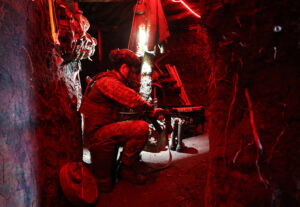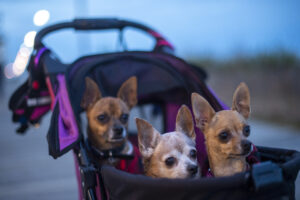A “big, white bear of a dog” called Bayraktar, named after the Turkish-made drone that neutralised a Russian convoy heading for Kyiv; a scarred black poodle called Dishika, after the belt-fed, tripod-mounted DShK machine gun that has taken down dozens of Russian drones; even a donkey named Himars, in reference to the US-supplied rocket launcher that has played a crucial role in recent Ukrainian gains… Social media is awash with images of pets rescued from harm’s way by Ukrainian forces, animal charities and, in some instances, the Russian invaders. As their militaristic names suggest, these are furry propaganda weapons — and they are being deployed by both sides.
As in any war, animals have suffered greatly in Ukraine, with hundreds of thousands of livestock — and millions of chickens — slaughtered in air strikes on industrial facilities and in wanton arson attacks. The bodies of hundreds of dolphins have washed up on Black Sea shorelines, the result of acoustic trauma from sonar. Ukraine has been particularly savvy in playing on Western fondness for animals as part of its highly effective media operation. And for the same reasons that Hollywood scriptwriters are advised to have their hero “save the cat” in opening sequences to ensure audience sympathy, it’s hard to be unmoved by the bravery of animal rescue charities operating under fire.
“People whose neighbourhoods are being shelled think about their animals first, and hand them over to us, sobbing,” one volunteer working in an animal-evacuation charity told me. “Military men and women, meanwhile, find comfort in these pets and see them as one of the few good things in their lives.” Even so, the focus on animals can grate, particularly when these sentiments seem to exceed the compassion extended to human victims of war. In the opening weeks of the conflict, certain neighbouring countries opened their borders to pets accompanying their owners, but failed to extend the same courtesy to African students stranded by the invasion.
The most famous animal hero in Ukraine is a mine-detection dog called Patron, a Jack Russell terrier whose name in Ukrainian means bullet cartridge. Patron was awarded the Order of Courage by President Volodymyr Zelenskyy, given his own animated YouTube series, appointed Unicef’s official goodwill “ambassadog” to Ukraine, and even hailed at the Cannes Film Festival for his “dogmanitarian work”.
A similar, slightly daft personification is at play in other news reports, as with that of the “abandoned Russian war dog” who “swapped sides” and has now “learned to understand Ukrainian”. In contrast, when Russian troops “adopted” a raccoon from Kherson zoo as their mascot, there was outcry, and Russian soldiers adopting strays are accused of “kidnapping” and “abduction”. Sporadic assertions such as the claim Russian soldiers eat dogs, while their Ukrainian opponents rescue them, serve a readily apparent purpose in dehumanising the invaders. In reality, one need not look far on social media to find equally propagandistic stories about Russian soldiers “saving” dogs from “drunken” Ukrainians.
With the assistance of sympathetic journalists, both parties in the conflict are engaging in a age-old tradition of using animals as propaganda stooges. Alexander’s Bucephalus was a steed so famous he gave his name to a city in modern-day Pakistan. Simón Bolívar’s horse, Palomo, a gift from an elderly peasant woman, became a symbol of national liberation, while Napoleon’s image was burnished by association with his horse, Marengo — the more so since, in reality, the Emperor was an inept horseman.
By the start of the 20th century, animals were being adopted as talismanic mascots: from Old Douglas, the domesticated camel used by the Confederate Army during the American Civil War, to Private Simpson, a stretcher-bearer at Gallipoli who used donkeys to help save a reputed 300 injured men, and Unsinkable Sam, the ship’s cat rescued by the Royal Navy from the wreckage of a Kriegsmarine battleship. Increasing empathy for these war pets was reflected in their commemoration as military heroes, particularly in the Anglosphere where, ever since the First World War, animals have been decorated for their “service”. At the same time, the unthinking, slavish loyalty of tame beasts reflected principles of hierarchy, valour and blind sacrifice essential to contemporary armies — as suggested by the famous “lions led by donkeys” formula, or the recruitment poster demanding: “Even a Dog Enlists, Why Not You?” The mascots represent both personal, heroic ideals and the de-personalising effect of attrition warfare.
More importantly, the treatment of animals gradually came to be recognised as a metric of humanity and good conduct. In the 19th century, the US and UK Societies for the Prevention of Cruelty to Children were founded after, and using the model established by, Societies for the Prevention of Cruelty to Animals. Come the Second World War, Joachim von Ribbentrop was pilloried in the British tabloids for leaving behind a Chow called Bärchen when abandoning the German embassy in London, in an act described as representing “the inherent brutality of Nazism that has no justice or human feeling, even for its pets”. (The British press was slower to castigate the hysterical cull on the eve of the war of more than 750,000 cats and dogs, in London and elsewhere, in panicked response to anticipated food shortages that never materialised.)
At the same time, of course, the Nazis sought to present themselves as defenders of animal welfare, opposing the alleged cruelty of kosher butchering. Nazi Germany was the first nation to ban vivisection, and to this day Germany uses animal welfare laws first introduced by the Nazis. Clearly, a rhetorical or actual commitment to animal welfare does not necessarily correlate to compassion for one’s fellow man.
Nonetheless, given public empathy for animals, accusations of their maltreatment by enemy forces are a reliable way of representing the cruelty of their opponents — as with occasional reports of Islamic militants strapping improvised bombs to donkeys. Frequently, however, the media’s representation of animal rescue operations is often designed to serve a political agenda, burnishing some group’s reputation and denigrating another’s. These contradictions are nowhere more pronounced than in Palestine, where I visited a depressing little zoo in the Gaza Strip, run by an amateur taxidermist, a lumpy stuffed giraffe standing as an unsteady testament to the destruction wrought by Israeli bombing.
In 2019, Four Paws, a charity now involved in animal rescue operations in Ukraine, made headlines by saving starving animals at that zoo. Back then, Fathy Jomaa, the zoo owner, tried to join the dots between the grim conditions endured by his animals and a decade of blockades that have forced the majority of Gazans to subsist below the poverty line on less than $5 a day. Unable to properly feed and care for his emaciated charges, more than 40 animals, including lions, monkeys, ostriches and a hyena, were taken in by other zoos. “I feel like I’m losing my family,” Jomaa lamented. But the barrage of criticism directed at him from animal rights groups, in reports that the animals were able to “escape” a “zoo of sorrows”, suited Israel’s ends perfectly. That is the benefit of pet propaganda: weaponising animals is a surefire way to win hearts and minds, an Instagrammable distraction from the less sanitised realities of war.
On the ground, meanwhile, the negative impact of war on animals remains a serious issue, with the mass death and displacement of livestock and wildlife leading to serious consequences for human populations in ways researchers are just beginning to explore. It’s in this sense that Ukraine’s claim that Russia is committing “ecocide” must be understood. But Kyiv has also learned to play the media game: and these structural eco-issues are never going to have the same sentimental appeal as a puppy plucked from the rubble and “recruited” into information warfare.
Disclaimer
Some of the posts we share are controversial and we do not necessarily agree with them in the whole extend. Sometimes we agree with the content or part of it but we do not agree with the narration or language. Nevertheless we find them somehow interesting, valuable and/or informative or we share them, because we strongly believe in freedom of speech, free press and journalism. We strongly encourage you to have a critical approach to all the content, do your own research and analysis to build your own opinion.
We would be glad to have your feedback.
Source: UnHerd Read the original article here: https://unherd.com/



